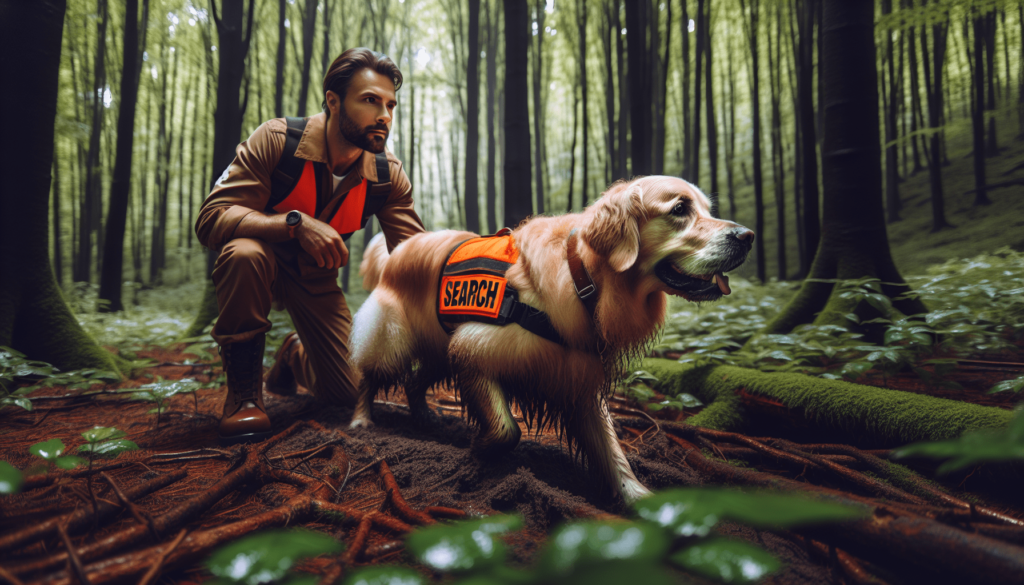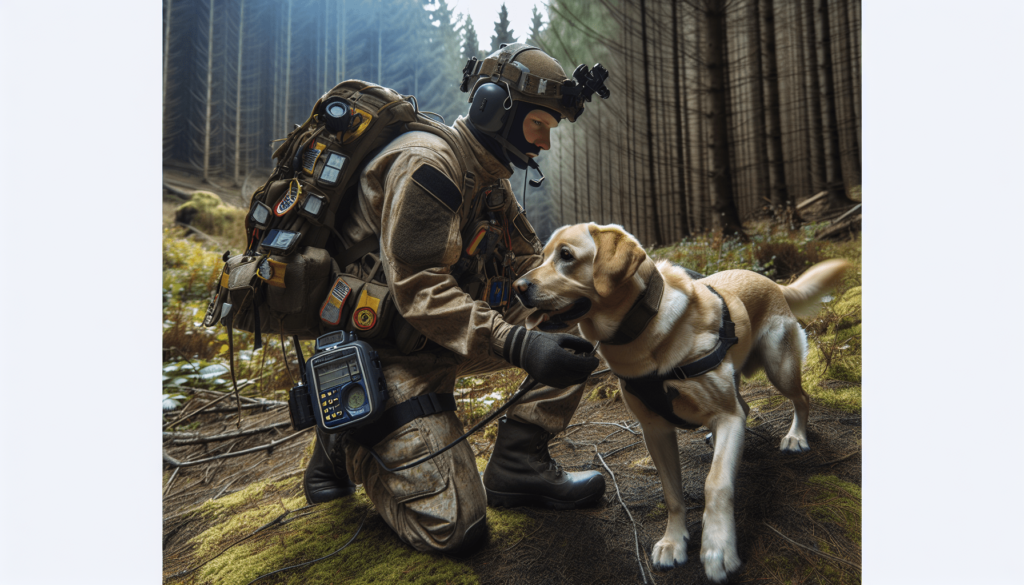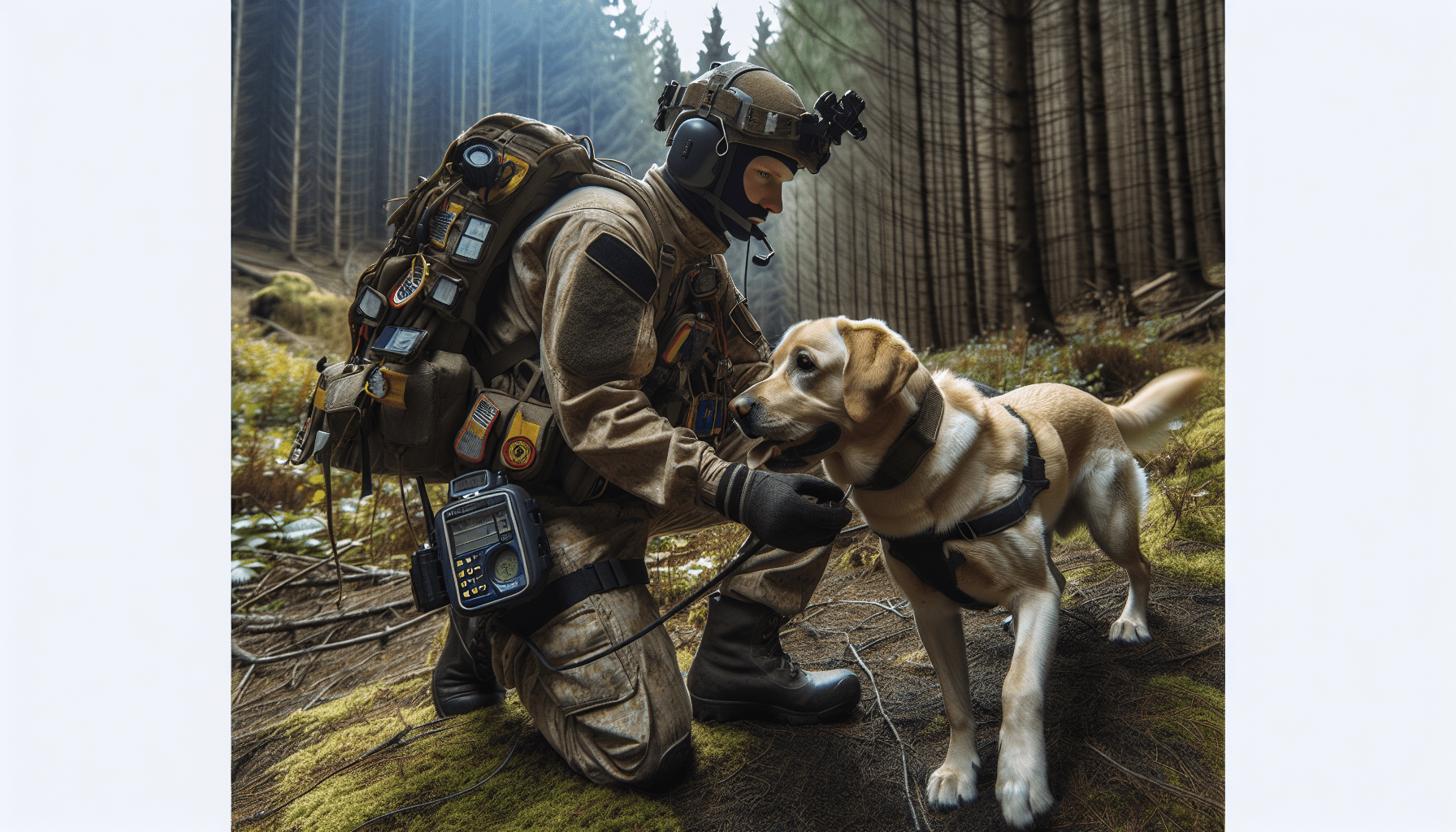If you’ve ever marveled at the incredible work done by search and rescue dogs, you may have wondered how these amazing animals are trained to perform such vital tasks. In this article, we will explore the fascinating world of training dogs for search and rescue missions. We’ll discuss the key skills and techniques involved in this specialized training, as well as the qualities that make a dog well-suited for these important tasks. So, whether you dream of working with these heroic canines or simply want to understand the power of their capabilities, read on to discover how to train your dog for search and rescue.
Understanding the Role of a Search and Rescue Dog
The Purpose of Search and Rescue Dogs
Search and Rescue (SAR) dogs play a crucial role in locating and rescuing missing individuals in various situations. These highly trained canines are often deployed in emergency situations such as natural disasters, wilderness searches, and urban environments. The primary purpose of SAR dogs is to use their exceptional sense of smell and tracking abilities to locate and alert their handlers to the presence of missing persons. Their dedication and skills are invaluable in saving lives and providing reassurance to those in distress.
The Traits and Characteristics of a Good Search and Rescue Dog
Not every dog is suitable for search and rescue work. Certain traits and characteristics are essential for a dog to excel in this role. SAR dogs need to possess a strong work drive, intelligence, and excellent problem-solving skills. High energy levels and physical endurance are also necessary to endure long hours of demanding work. Additionally, SAR dogs must have a calm and stable temperament, allowing them to remain focused and obedient in high-pressure situations. These dogs should be adaptable, responsive to training, and possess a strong sense of loyalty towards their handlers. The combination of these traits makes for a well-rounded and effective search and rescue dog.
Choosing the Right Breed for Search and Rescue
Working Dog Breeds Ideal for Search and Rescue
When considering a breed for search and rescue work, it is important to choose a breed that is well-suited for the job. Working dog breeds such as German Shepherds, Labrador Retrievers, Belgian Malinois, and Border Collies are commonly chosen for their intelligence, physical stamina, and scenting capabilities. These breeds have a long and successful history in search and rescue operations. Their natural instincts and abilities make them highly reliable in locating missing individuals. However, it is important to note that individual dogs may vary, and not all members of these breeds will be suitable for SAR work.
Considerations When Selecting a Breed
While working dog breeds are often the top choice for search and rescue work, several considerations should be taken into account when selecting a breed. Size is an important factor, as larger breeds can be advantageous in certain situations, such as wilderness searches. Additionally, the dog’s coat should be suitable for the environment in which they will be working. Long-haired breeds may struggle in hot conditions, while short-haired breeds may require additional protection in cold climates. Temperament and trainability are also important factors to consider, as well as the dog’s overall health and genetic predisposition to certain conditions. Ultimately, the breed should align with the specific search and rescue needs and requirements.

Building a Strong Foundation with Basic Obedience Training
Importance of Basic Obedience Training for Search and Rescue Dogs
Basic obedience training is the foundation for any successful search and rescue dog. It establishes clear communication and builds a solid working relationship between the handler and the dog. Obedience training teaches the dog essential commands and behaviors, ensuring that they can work effectively and safely in the field. Commands such as sit, stay, and recall are vital for maintaining control and preventing the dog from getting into potentially dangerous situations. Furthermore, basic obedience training helps instill discipline and focus, allowing the dog to perform their job with precision and reliability.
Teaching Sit, Stay, and Recall Commands
The sit, stay, and recall commands are among the most important commands for a search and rescue dog to learn. Teaching the sit command involves getting the dog to sit in a stationary position and hold it until released by the handler. Stay command teaches the dog to remain in position, even in the presence of distractions or while the handler moves away. Recall command ensures that the dog comes back to the handler promptly upon command, regardless of the surrounding circumstances. Consistency, positive reinforcement, and regular practice are key when teaching these commands. With patience and persistence, the dog will become fluent in these essential obedience skills.
Training Techniques and Positive Reinforcement
Positive reinforcement is a highly effective training technique for search and rescue dogs. This method involves rewarding the dog for desired behaviors, such as following commands or exhibiting the right attitude. Rewards can range from verbal praise, treats, or playtime with their favorite toy. By associating these rewards with the correct behavior, the dog learns to repeat the desired actions willingly. Positive reinforcement not only builds a strong bond between the handler and the dog but also creates a positive and enjoyable learning experience. Harsh or punitive training methods should be avoided, as they can undermine the dog’s confidence and hinder their progress.
Scent Training: Developing Your Dog’s Sense of Smell
The Importance of Scent Training in Search and Rescue
Scent training is a fundamental aspect of search and rescue work. Dogs possess an incredible sense of smell that far exceeds that of humans, making them invaluable in locating missing individuals. By capitalizing on their olfactory capabilities, SAR dogs are trained to recognize and follow specific scents associated with human presence. Scent training allows dogs to distinguish between various smells and track the scent from its origin to the source. This vital skill enables them to cover large areas efficiently while focusing on finding the missing person.
Teaching Your Dog to Recognize and Locate Specific Scents
To teach a search and rescue dog to recognize specific scents, a gradual process of association is used. The dog is introduced to the scent by pairing it with a highly rewarding experience, such as playtime or treats. Over time, the dog forms a positive association with the scent, becoming motivated to locate it. The scent is gradually faded into harder-to-find locations, challenging the dog’s ability to follow and locate the scent. This process helps the dog develop the skills needed to identify and track specific scents in diverse environments.
Using Scent Articles and Tracking Trails
Scent articles and tracking trails are essential tools in scent training for search and rescue dogs. Scent articles are objects that are contaminated with the missing person’s scent and are used to familiarize the dog with their specific scent characteristics. These can include items such as clothing, personal belongings, or gauze pads. The dog learns to associate the scent with a coming reward, enhancing their motivation to locate individuals with matching scents. Tracking trails, on the other hand, involve creating a clear trail for the dog to follow, typically using a scent item. By gradually increasing the difficulty of the trail, the dog develops their tracking skills and learns to follow a specific scent path.

Introduction to Search and Rescue Training
Understanding the Different Types of Search and Rescue Missions
Search and rescue missions can vary widely depending on the specific circumstances and environments involved. There are several types of search and rescue operations, including wilderness searches, urban searches, disaster response, and cadaver searches. Each type of mission requires different skills and training techniques for the search and rescue dog. By understanding the nuances and requirements of each mission type, handlers can prepare their dogs accordingly and maximize their effectiveness in the field.
Preparing Your Dog for Search and Rescue Work
Preparing a dog for search and rescue work involves exposing them to various training scenarios that simulate real-life situations. This includes introducing them to different surroundings, noises, and distractions they may encounter during searches. Additionally, it is crucial to gradually increase the difficulty of the training exercises to challenge the dog’s abilities and adaptability. Consistent and focused training sessions, coupled with a positive and supportive environment, lay the groundwork for a successful search and rescue partnership.
Safety Measures and Equipment
Safety is paramount in search and rescue operations, and proper equipment is essential for the well-being of both the dog and the handler. Dogs should always wear a well-fitting harness or vest that allows for freedom of movement while providing control. Identification tags and microchipping are crucial in case the dog becomes separated from their handler. Other safety measures may include using protective boots for rugged terrain, working in teams to ensure mutual assistance, and employing proper safety protocols to minimize risks during search and rescue missions.
Teaching Search Techniques and Behavior
Teaching Your Dog to Perform Area Searches
Area searches involve the dog covering a designated area in search of a missing person. To teach this technique, the dog is trained to systematically sweep the area, utilizing their natural ability to detect scents. Handlers often use specific search patterns, such as a grid pattern or a spiral pattern, to ensure thorough coverage of the area. The dog is rewarded for finding hidden objects or indicating the presence of a scent, positively reinforcing the desired behavior. Through consistent training and reinforcement, the dog becomes proficient at conducting effective area searches.
Teaching Your Dog to Follow Trails and Tracks
Tracking is another essential search technique for search and rescue dogs. Dogs are trained to follow a specific scent trail left by a missing person, navigating various terrains and conditions. The training process involves gradually increasing the difficulty of the tracks, incorporating turns, crossings, and varying scent intensities. The dog learns to track the scent trail while staying focused and maintaining a steady pace. By reinforcing successful tracking behaviors, handlers can fine-tune their dog’s tracking skills and enhance their ability to follow trails accurately.
Teaching Your Dog to Indicate and Alert
An important part of search and rescue training is teaching the dog to indicate and alert when they find the missing person or detect their scent. This can be achieved through various methods, such as sitting, barking, or pawing at the source of the scent. The dog must learn to communicate effectively with their handler, clearly indicating that they have located the target. Consistent training and positive reinforcement are key to developing reliable indication and alert behaviors in search and rescue dogs.
Working with Distractions and Difficult Terrain
Training Your Dog to Ignore Distractions
Search and rescue operations can be unpredictable and filled with distractions that can divert a dog’s attention. Training a search and rescue dog to ignore distractions is crucial for maintaining focus and ensuring the dog remains dedicated to their task. By gradually introducing distractions during training sessions, such as noise, other animals, or food, the dog learns to remain focused on their handler’s commands and objectives. Consistent reinforcement of desired behaviors helps the dog understand that distractions should be ignored during search and rescue operations.
Introducing Your Dog to Different Terrains
Search and rescue dogs must be comfortable working in various terrains, including forests, mountains, bodies of water, and urban settings. Introducing a dog to different terrains gradually is important to build their confidence and adaptability. Basic obedience and search techniques are reinforced in different environments, allowing the dog to acclimate and perform effectively no matter the terrain they encounter. Handlers should ensure the safety and well-being of their dog during training exercises, providing appropriate gear and monitoring their dog’s condition during challenging terrain work.
Overcoming Challenges and Obstacles
Challenges and obstacles are inevitable in search and rescue operations. Dogs may encounter physical barriers, such as collapsed buildings or rough terrain, which can hinder their progress. Training exercises that simulate real-life scenarios help prepare dogs to overcome these challenges. By gradually increasing the difficulty of the exercises and incorporating obstacles into the training sessions, dogs learn to problem-solve and find alternative routes. Handlers play a crucial role in guiding their dogs through challenging situations, reinforcing their confidence and perseverance.
Mock Exercises and Training Scenarios
Simulating Realistic Search and Rescue Scenarios
Mock exercises and training scenarios are an essential part of preparing search and rescue dogs for actual missions. These exercises simulate real-life scenarios, allowing dogs to apply their training in a controlled environment. Mock exercises can include scenarios such as finding hidden individuals, locating scent articles, or following complex trails. Regular participation in these exercises helps dogs develop and maintain their skills, ensuring they are well-prepared for the challenges they may encounter during actual search and rescue missions.
Utilizing Training Aids and Props
Training aids and props are valuable tools used in mock exercises and training scenarios. Scent articles, as mentioned earlier, are used to familiarize dogs with specific scents associated with missing individuals. Props such as rubble piles, climbing structures, or man-made search areas provide realistic training environments that simulate real-life situations. These aids assist in developing the dog’s problem-solving abilities and acclimating them to the challenges they may encounter during search and rescue missions.
Evaluating and Assessing Your Dog’s Performance
Regular assessments and evaluations of a search and rescue dog’s performance are essential for tracking progress and identifying areas that require improvement. Handlers can track their dog’s performance through documentation, including achievements, challenges, and areas for further development. Evaluations can also involve working with experienced trainers or other search and rescue professionals who can offer guidance and feedback. By continually assessing and adjusting training techniques, handlers can help their dog reach their full potential in search and rescue work.
Building Trust and Teamwork
Establishing a Strong Bond with Your Dog
Trust is the foundation of any successful search and rescue team. Establishing a strong bond between the handler and the dog is crucial for effective communication and teamwork. Building trust involves spending quality time together, reinforcing positive experiences, and consistently providing for the dog’s needs. Consistency, patience, and understanding are key to nurturing the bond between handler and dog, creating a relationship built on mutual respect and trust.
Communicating Effectively as a Search and Rescue Team
Effective communication between the handler and the search and rescue dog is paramount during missions. Dogs rely on their handler’s cues, verbal commands, and body language to understand what is expected of them. Handlers must learn to use clear and consistent commands, highlighting specific behaviors and actions. Dogs, in turn, learn to interpret these cues and respond accordingly. This clear and effective communication ensures that handler and dog work seamlessly together as a team, maximizing their efficiency and success.
Developing Trust and Confidence in Your Dog’s Abilities
Search and rescue work can be challenging and demanding, both physically and mentally, for both the dog and the handler. Developing trust and confidence in the dog’s abilities is crucial for effective teamwork and maintaining a positive working relationship. Handlers must have faith in their dog’s training and instincts, allowing them to work autonomously when required. By reinforcing positive behaviors and continually supporting the dog’s development, handlers can cultivate a sense of confidence and trust in their dog’s abilities.
Maintaining Physical and Mental Well-being
Regular Exercise and Conditioning
Maintaining the physical well-being of a search and rescue dog is essential for their performance in the field. Regular exercise and conditioning help build and maintain the dog’s strength, stamina, and endurance. Activities such as long walks, running, swimming, or agility training contribute to their overall fitness. The type and intensity of exercise should be tailored to the dog’s breed, age, and physical condition. Regular veterinary check-ups and appropriate nutrition also play a vital role in keeping the dog in optimum physical health.
Providing Mental Stimulation and Enrichment
In addition to physical exercise, mental stimulation is crucial for a search and rescue dog’s overall well-being. Mental enrichment activities, such as puzzle toys, obedience training sessions, or scent games, help keep the dog’s mind sharp and engaged. Search and rescue dogs thrive on mental challenges and problem-solving tasks, which can be integrated into training sessions or provided as separate enrichment activities. By providing a balance of physical exercise and mental stimulation, handlers can promote the dog’s overall mental and emotional health.
Medical Care and Preventive Measures
Regular medical care and preventive measures are essential components of maintaining a healthy search and rescue dog. Dogs should receive routine vaccinations, regular parasite prevention, and annual check-ups to ensure their overall health and well-being. Additionally, handlers should monitor the dog for any signs of illness or injury and seek veterinary attention as needed. Proper hygiene practices, including regular grooming and dental care, also contribute to the dog’s overall health and performance in search and rescue operations. Handlers must prioritize the physical and medical care of their search and rescue dog to ensure they are fit and ready for duty.
In conclusion, training a search and rescue dog requires dedication, patience, and a comprehensive understanding of the specific skills and behaviors required for success in this role. From choosing the right breed to developing advanced search techniques, every aspect of training contributes to the dog’s effectiveness in locating missing individuals. By establishing a strong bond, maintaining physical and mental well-being, and nurturing trust and teamwork, search and rescue dogs can fulfill their vital role in saving lives and providing hope in times of need.

